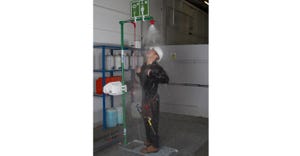Dust Collection 119
July 9, 2007
 In the early 1980s, the dust collection industry was in the midst of a changeover from shaker-type systems to compressed-air cleaning. With the exception of woodworking, large outdoor installations were primarily employing pulse-jet baghouses, which offered the best efficiency and smallest footprint. Shaker and vibratory cleaning were still popular for smaller indoor units, due, in part, to height restrictions. Pleated-cartridge dust collection was still in its infancy. High-quality ductwork was typically welded and flanged.
In the early 1980s, the dust collection industry was in the midst of a changeover from shaker-type systems to compressed-air cleaning. With the exception of woodworking, large outdoor installations were primarily employing pulse-jet baghouses, which offered the best efficiency and smallest footprint. Shaker and vibratory cleaning were still popular for smaller indoor units, due, in part, to height restrictions. Pleated-cartridge dust collection was still in its infancy. High-quality ductwork was typically welded and flanged.
Over the past 25 years, driven by increasing federal regulation as well as economics, some important advances have been made that have changed the way we design and install dust collection systems. The compact pleated-cartridge system is now the market leader for most applications, standard filtration efficiency is approaching HEPA levels, and prefabricated do-it-yourself ductwork can be purchased online. Things have definitely improved, and most of these improvements fall into three general categories: controls, filter media, and ductwork design.
While not immediately obvious, solid-state controls and fast-acting pulse valves are the main reason that modern baghouse and cartridge systems can be cleaned so effectively. Twenty-five years ago, compressed-air cleaning systems used a solid-state timer board with pilot-operated diaphragm valves. While this was far more effective than a shaker system, and it allowed systems to clean in-line with the fan running, it was not ideal. The early valves had a relatively long opening and closing time, which produced a “whoosh,” rather than a “boom.” According to Tony Brajdic, of Pinnacle APC, the new-generation “fast acting” valves may be the single most important component to hit the market and are the only valves that will properly clean a modern pleated cartridge in-line. All of the best systems now use fast-acting valves.
The second important category of innovation that we’ve seen, and certainly the most interesting, is the vast array of high-performance filter media that is currently available. Early filter media were limited to a few choices. For baghouse work, the designer could choose from 16-oz polyester, polypropylene, or Nomex felt, and for high-temperature work he used woven glass. While these are fine for many applications and are still in common use today, they often cannot provide the efficiency required to meet today’s tougher emission standards. Today we have micro-denier felt and PTFE laminates, which deliver much higher separation efficiency than commodity felts. For high-temperature applications, we can now choose from aromatic polyamide, PPS, polyimide, glass needle-felt, aramid, PTFE felt, and even woven ceramic rated to 700°F—all of which are readily available.
Pleated-cartridge media technology continues to grow by leaps and bounds. Early systems used 100%-cellulose media, or an expensive screen-backed felt. The cellulose cartridges were essentially truck filters that were somewhat more efficient than most felts of the time, but nowhere near the performance we see now. Today, we use blends of cellulose and polyester, which are much tougher and more efficient that the early cellulose media. In addition to improved media, there are also several nanofiber and PTFE surface laminates on the market that offer near-HEPA separation efficiency.
Another of the great developments to come along is filter-grade spunbonded polyester, which has an extremely high burst strength, as well as good permeability and excellent cleanability. Filters made of spunbonded polyester are able to clean in-line under some of the toughest conditions imaginable. Moist, sticky, or fibrous dust can now be dealt with using cartridge filtration, which was impossible just 15 years ago.
Ductwork has been the last big change industry has seen. Typically, about half the cost of a project goes into the ductwork, and historically, ductwork installers relied on fabricated flanged pipe. The drawback to flanged systems is the installation labor cost. Field installation of these systems is time-consuming, and plant personnel do not possess the skills to install or modify them once they are in place. The latest trend has been toward clamp-together piping, which is high quality, but is also simple to install and modify. Product is available in galvanized and stainless steel, and an entire system can typically ship in less than one week. These systems can be assembled by plant personnel and are easily modified. According to Tom Landis, of T.D. Landis Co., a snap-together system can be installed in about two-thirds the time of a flanged system, which can make a big difference in the cost of a project. While these new duct systems are not for everyone, the availability, ease of installation, and ability to perform quick field modifications make them ideal for many users.
Over the past 25 years we have seen great advances in the dust collection field, and we expect to see even more in the future. Tougher emissions standards and increasing energy costs will certainly play a role. As time goes on, we expect to see popularity grow in the nanofiber laminates, which offer increased filtration efficiency, as well as energy savings through reduced pressure drop. In addition, we expect to see increased use of variable-frequency drives, as well as premium-efficiency motors, which offer big savings in electrical usage. It will be interesting to see what the future brings for the dust collection industry, and we look forward to watching it grow.
A consultant for www.dustcollectorexperts.com, Rick Wynn and his father, Dick, founded Wynn Environmental Sales, Warwick, PA, in 1985. The Wynns specialize in the design and installation of dust and mist collection systems. In addition, Rick has designed baghouse dust collectors for Johnson March Systems and marketed filter bags for BWF America. Rick has recently been granted a U.S. patent for a new high-efficiency wet dust collection system. For more information call 215-442-9443 or visit www.wynnenv.com.
About the Author(s)
You May Also Like




